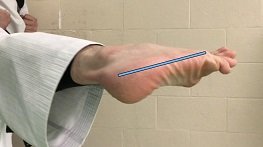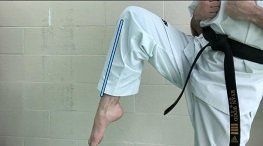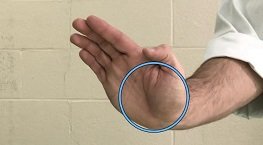Anatomy
신체 부분
Italicized text following Hangul is the approximate phonetic pronunciation.
Body Parts Applicable In Offense & Defense
There are other surfaces used but this covers the most common areas with the most realistic applications.
Instep
Bal Deung
발 등
“Bahl Doong”
The broad section on the top of the foot, not including the toes.
Ball of the Foot
Ap Chuk
앞 축
“Ahp Chook”
The front area of the sole of the foot. The toes should be pulled back when delivering a strike with the ball of the foot.
Bottom Of The Heel
Dwi Chuk
뒤 축
“Dwee Chook”
The rear part of the bottom of the foot.
Back Of The Heel
Dwikkumchi
뒤꿈치
“Dwee-Koom-Chee”
The edge of the heel where it joins the Achilles tendon. Using this section of the foot requires extreme precision in order to avoid hitting with the tendon itself.
Sole of the Foot
Bal Badak
발 바닥
“Bahl Bah-Dahk”
The bottom of the foot from the heel to the ball.
Foot Blade
Bal Nal
발 날
“Bahl Nahl”
Outer Foot Blade. The outer edge of the foot from the small toe to the heel.
Reverse Foot Blade
Bal Nal Deung
발 날 등
“Bahl Nahl Doong”
Inner Foot Blade. The inner edge of the foot from the big toe to the heel.
Shin
Jeonggangi
정강이
“Juhng-Gahng-Ee”
Specifically the tibia bone, located on the front of the lower section of the leg.
Knee
Mureup
무릎
“Moo-Roop”
The front surface of the hinge joint between the upper and lower leg. The leg should be bent to its maximum when being used to strike.
Foot
Bal
발
“Bahl”
The section of leg below the ankle joint. Can be made into various shapes depending on the desired application.
Leg
Dali
다리
“Dah-Lee”
The area encompassing the top of the femur bone to the bottom of the shin.
Hand
Son
손
“Sohn”
The section of arm below the wrist joint. Can be made into many various shapes depending on the desired application.
Palm Heel
Batangson
바탕손
“Bah-Tahng-Sohn”
The base of the hand, below the palm itself.
Fist
Jumeok
주먹
“Joo-Muhg”
The hand is clinched with the thumb folded over the middle phalanges. The first two knuckles are used to deliver punching techniques
Back Fist
Deung Jumeok
등 주먹
“Doong Joo-Muhg”
The back section of the first two knuckles of a clenched fist.
Hammer Fist
Me Jumeok
메 주먹
“May Joo-Muhg”
The outside edge of a clenched fist.
Knife Hand
Sonnal
손날
”Sohn-Nahl”
Also known as “Hand Blade” and “Hand Knife”. The outside section of the hand from the base of the pinky finger to the wrist. The thumb is folded alongside the opposite edge of the hand and the first three fingertips form a uniform surface by bending the first two fingers to match the length of the third.
Ridge Hand
Sonnal Deung
손날 등
“Sohn-Nahl Doong”
Also known as the “Reverse Hand Blade”. The inside section of the hand from the base of the index finger to the wrist. The thumb is tucked across the palm and the first three fingertips form a uniform surface by bending the first two fingers to match the length of the third.
Spear Hand
Pyeonsonkkeut
편손끝
“P’yuhn-Sohn-Koot”
The striking surface formed by bending the second and third fingers, making the first three fingers match in length. Used exclusively on soft targets like the throat and eyes.
One realistic application of the Spear Hand would be holding the back of someone’s head while pressing the flattened fingertips into their trachea.
Arc Hand
Ageumson
아금손
“Ah-Goom-Sohn”
With the hand open, the edge produced between the tip of the thumb and the tip of the curled index finger, forming a crescent shape. The wrist should not be flexed back, but rather moved in a way that the center of the arc lines up with the center of the arm. Used to strike the throat.
Formerly referred to as 칼재비 Kaljaebi.
Inner Forearm
An Palmok
안 팔목
“Ahn Pahl-Mohk”
The radius bone. Also referred to as the Inner Wrist.
Outer Forearm
Bakkat Palmok
바깥 팔목
“Bah-Kaht Pahl-Mohk”
The ulna bone. Also referred to as the Outer Wrist.
Elbow
Palgup
팔굽
“Pahl-Goop”
The outer part of the hinge joint where the upper and lower arm meet. The elbow should be bent to its maximum when being used in a strike.
Also called Palkkumchi 팔꿈치
Arm
Pal
팔
“Pahl”
The area encompassing the top of the shoulder to the bottom of the wrist.
Extended Knuckle Fist
Bamjumeok
밤주먹
“Bahm-Joo-Muhg”
The second finger’s middle knuckle is extended while being braced from below by the thumb. Used exclusively on soft targets such as the throat, usually in a pressing motion rather than as a strike.



























